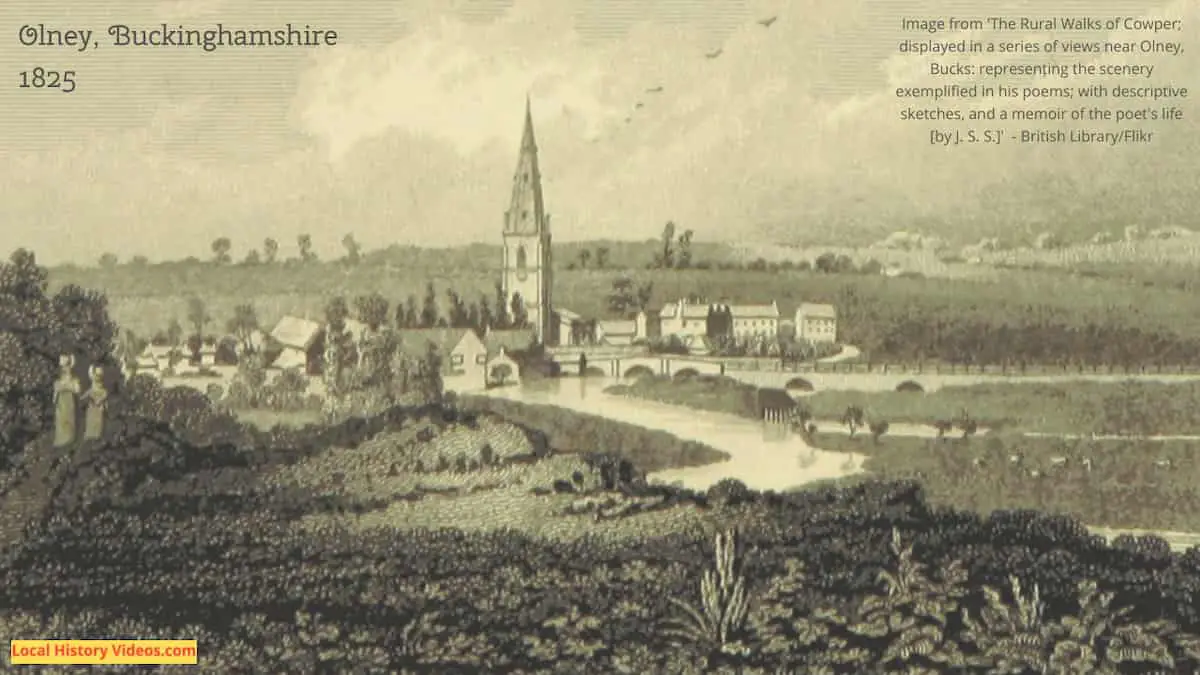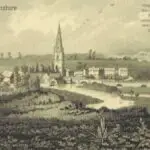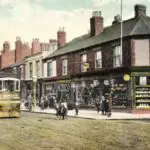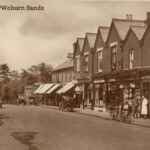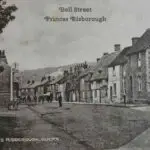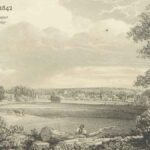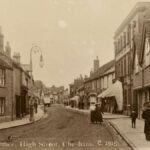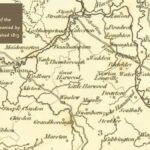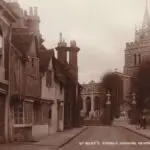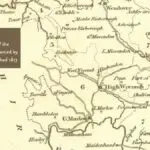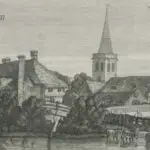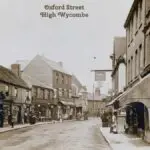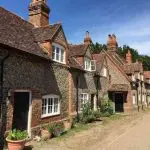Glimpse history through old images of Olney, Buckinghamshire, England.
Pancake Day (1927)
Silent footage of a pancaske race in 1927 shows a few houses in the background.
Pancake Day at Olney (1927) – British Pathé on YouTube
Pancake Race (1951)
A 1951 newsreel features 35 housewives running through Olney’s streets in the Shrove Tuesday Pancake Race. There are several nice shots of local buildings.
Pancake race at Olney (1951) – British Pathé on YouTube
Shrove Tuesday (1952)
A huge turnout of people were captured on a 1952 newsreel about the Shrove Tuesday Pancake Race.
Mrs. Isabel Dix, who won the race in 1951, was again pronounced the winner.
It opens with a lovely shot of two buses waiting behind the crowd, the street disappearing off in to the distance behind them.
As the ladies run past the archway leading to a garage, the next shot shows the street of shops and homes lined with spectators.
At the end, we see everyone assembled in the church grounds, where the verger kisses Mrs Dix on the cheek….and then gives her a very strange embrace from behind.
People In The News (1952) – British Pathé on YouTube
A bit of Olney history
Extract: A Handbook for Travellers in Berks, Bucks, and Oxfordshire, Including a Particular Description of the University and City of Oxford, and the Descent of the Thames to Maidenhead and Windsor …, by John Murray (Firm)
Published in 1860
Pages 129 – 130
5 m. N. of Newport, in a dreary plain, only enlivened by the windings of the Ouse, is Olney (Inn: Bull), so celebrated as the home of Cowper the poet.
The spire is conspicuous long before reaching the town, which is entered by a bridge of four arches crossing the Ouse, with several smaller ones over the meadow – land flooded in winter, which is alluded to by Cowper in the lines,
” Hark ! ‘ t is the twanging horn o’er yonder bridge,
That, with its wearisome but needful length,
Bestrides the wintry flood.”
rt. is the large ch. of SS. Peter and Paul, entirely Dec. The pulpit is that in which Newton and Scott the commentator preached.
The town, the most N. in Bucks, consists of one long street, the houses built of stone, but by far the greater number thatched.
At one corner of the market – place, rather taller than the surrounding houses, is Cowper’s House, which wears a most desolate aspect.
It was engaged for him in 1767 by his friend Newton (then rector), and was so near the vicarage, that by opening a door in the garden – wall they could communicate without going into the street.
Here he was induced by Newton to join with him in the authorship of the Olney Hymns.
‘Occurrences here are as rare as cucumbers at Christmas,’ he wrote in one of his letters, but he entered upon what he called a decided course of Christian happiness; and it was by no means unusual to find the man of trembling sensibilities praying by the sick – bed of the poorest or guiding the devotions of some miserable being who attempted to seek God only in the departing moments of existence.
The town, which Cowper describes as populous, and inhabited chiefly by ‘the half – starved and ragged of the earth, ‘afforded him ample facilities for usefulness.
Lacemaking furnished, even to unremitting diligence, so scanty a pittance that it was barely sufficient to maintain a miserable existence.
When a charitable donation enabled the poet to provide six children with one pair of blankets, they jumped out of their straw, caught them in their arms, kissed them, blessed them, and danced for joy.
The majority of the people were brutal in their manners and heathenish in their morals. Little creatures seven years of age made the place resound every evening with curses and villanous songs; the cottages were disposed in a long dreary street, and the tottering mud walls and torn thatch of many of them were in keeping with the wretchedness of the inmates.
The surrounding meadows were flooded during winter; and Cowper was often doomed to sit for months over a cellar filled with water. The air in the rainy season was impregnated yet with the fishy – smelling fumes of the marshi miasma; and to this he attributed the slow and spirit – oppressing fever which visited all persons who remained long in the locality.
None of these evils had much effect upon him during the early years of his residence. He was experiencing the truth that the mind is its own place, and the social and spiritual advantages he enjoyed made Olney a heaven to him.
Cowper’s Garden is behind his house, but now belongs to a different proprietor: it is however readily shown to visitors. Here is “the gravel walk, 30 yards long, which afforded but indifferent scope to the locomotive faculty, and which yet,” says Cowper,” was all we had to move on for eight months in the year.”
Here is the house in which he kept his tame hares, his chief amusement. ” They grew up under his care, and continued to interest him for nearly twelve years, when the last survivor died quietly of mere old age. He has immortalised
them in Latin and in English, in verse and in prose. They have been represented in prints and cut on seals; and his account of them, which in all editions of his poems is now appended to their epitaphs, contains more observations than had ever before been contributed to the history of this inoffensive race.”
In this garden also is Couper’s Summer Parlour, concerning which he writes, “We eat, drink, and sleep where we always did; but here we spend all the rest of our time, and find that the sound of the wind in the trees and the singing of birds are much more agreeable to our ears than the incessant barking of dogs and screaming of children.”
“At Olney the Ouse changes its character; and its course becomes so winding that the distance from that place to St. Neot’s, which is about 20 m. by land, is about 70 m. by the stream. This has not escaped Drayton in his description of this ‘ far wandering ‘ river:”
” Ouse having Oulney past, as she were waxed mad, From her first stayder course immediately doth gad,
And in meandering gyves doth whirl her self about,
That, this way, here and there, back, forward, in and out;
And like a wanton girl, oft doubling in her gait,
In labyrinth – like turns and twinings intricate,
Thro ‘ those rich fields doth run.”
” The walks here are beautiful,” says Cowper,” but it is a walk to get at them. Weston [ Underwood ], our pleasantest retreat, is 1 m. off, and there is not in that whole mile so much shade as would cover you. Mrs. Unwin and I have for many years walked thither every day when the weather would permit; and, to speak like a poet, the limes and elms of Weston can witness for us both how often we have sighed and said, ‘ Oh that our garden – door opened into this grove or into this wilderness, for we are fatigued before we reach them, and, when we have reached them, have not time to enjoy them.”
The state of the road was often so bad that it gave rise to the rhyme,
“ Sle, sla, slud,
Stuck in the mud,
Oh, it is pretty to wade through a flood.”
Nevertheless, in Aug. 1780, Cowper and Mrs. Unwin thankfully removed to Weston, where they lived in a house still to be seen on rt. of the village.” We dwell,” wrote the poet,” in a neat and comfortable abode in one of the prettiest villages in the kingdom. It affords opportunity of walking at all seasons, abounding with beautiful grass grounds which encompass it on all sides to considerable distance. These grounds are skirted by woods of great extent.” Below, in the valley,” Ouse’s silent tide” flows through the green meadows. There is a good view from the Cliff”.
More about Buckinghamshire
- Old Images of Buckinghamshire, England
- Old Images of Wolverton, Buckinghamshire
- Old Images of Woburn Sands, Buckinghamshire
- Old Images of Princes Risborough, Buckinghamshire
- Old Images of Olney, Buckinghamshire
- Old Images of Newport Pagnell, Buckinghamshire
- Old Images of Chesham, Buckinghamshire
- Old Images of Bletchley, Buckinghamshire
- Old Images of Aylesbury, Buckinghamshire
- Old Images of Amersham, Buckinghamshire
- Milton Keynes: Old Photos & Film
- Old Images of Beaconsfield, Buckinghamshire
- Old Images of Marlow, Buckinghamshire
- High Wycombe History: Old Photos & Film
- Buckinghamshire, England: Local History Resources

